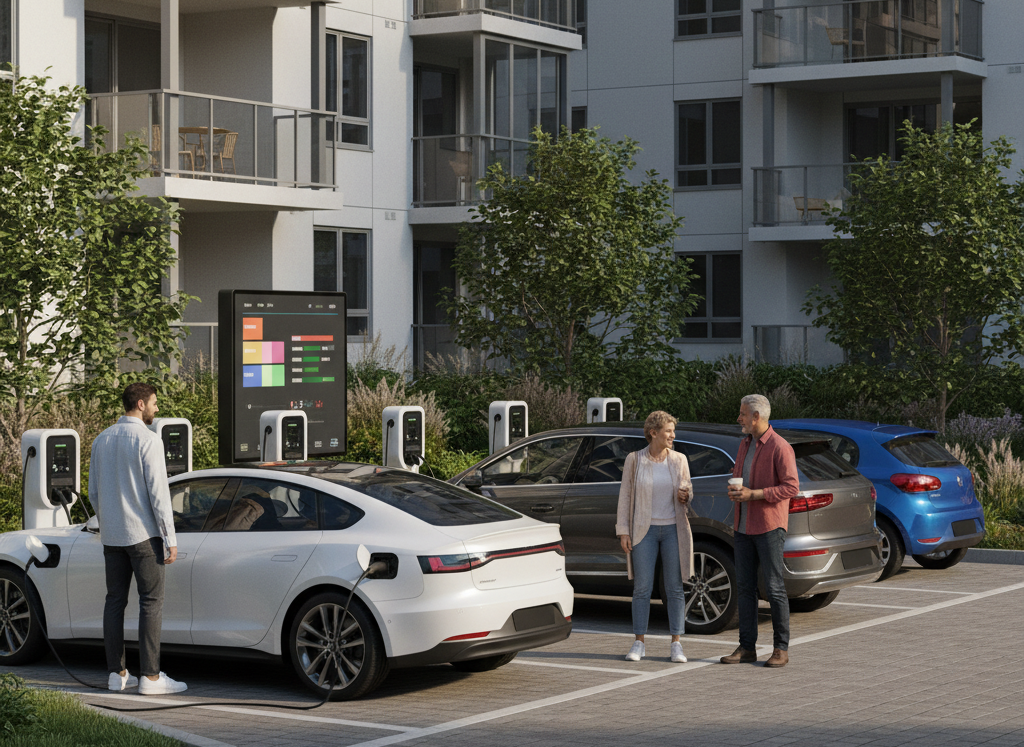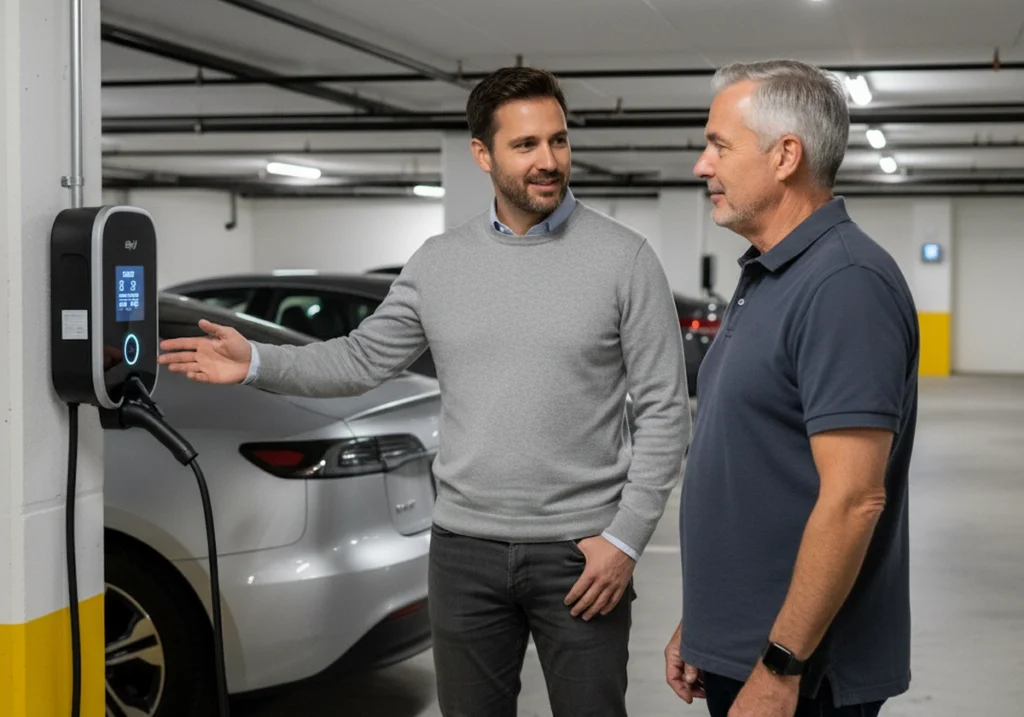Buying an electric vehicle feels exciting until you realise apartment EV charging isn’t set up yet. Your body corporate doesn’t seem to have a clear policy. What’s more, asking about installation gets you vague responses or outright confusion.
You’re not stuck. This guide walks you through real solutions for strata properties without private garages. You’ll learn about your legal position in community schemes, how to get body corporate approval, and what charging options exist on common property.
We’ll also cover how to address concerns from other owners. Besides, residents in apartments across Australia are charging their vehicles successfully.
Read on to learn everything you need to know about making apartment EV charging work for you.
Your Legal Rights for EV Charging in Strata Properties
Your body corporate can’t simply reject your request anymore. After all, laws across Australia have changed to support EV owners who want charging infrastructure installed at their strata properties.
Though different states have different rules, the trend remains clear:

NSW: The ‘Must Not Unreasonably Refuse’ Rule
Let’s take New South Wales, for instance. Their strata legislation requires owners’ corporations to assess EV charging applications fairly. On top of that, refusal needs valid grounds.
Basically, your proposal must include electrical safety reports, insurance details, and show no harm to common property.
Don’t worry, without solid reasons, the body corporate can’t turn you down.
Victoria and Queensland: What the Law Backs
Similar protections exist for residents in Victoria’s strata schemes. The state’s legislation acknowledges that vehicle charging has become standard infrastructure.
Queensland’s body corporate framework takes the same approach for apartment owners wanting chargers on common property. You’ll need to follow the approval process and meet building safety standards. That said, the law supports your request.
Knowing these rights puts you in a stronger position with your strata committee. Now let’s talk about how the approval process works in practice.
Body Corporate Approval: How to Get a Yes
The approval process can move quickly if you come prepared. Not to mention, most body corporate committees want to say yes. They just need reassurance that you’ve considered the practical details.
What helps your application succeed:
- Formal Written Request: Start by citing your strata scheme’s by-laws and explaining how the charger fits on common property. Bear in mind that committees appreciate seeing you understand the rules and have planned around potential concerns from other owners.
- Licensed Electrician Quotes: Your building’s electrical capacity needs a professional assessment first. We suggest you attach quotes from electricians who confirm the work meets Australian safety standards. Plus, older apartment buildings sometimes need minor upgrades, so knowing this upfront prevents delays.
- Clear Metering Plan: Other owners want proof they won’t subsidise your electricity usage through shared costs. So, you should outline how you’ll track and pay for your own consumption. Luckily, smart meters or dedicated circuits make this straightforward and keep everyone comfortable with the arrangement.
- Insurance Documentation: The body corporate needs protection against installation damage or ongoing liability issues. Don’t forget to provide coverage details that reassure the committee that your insurer handles any problems. Some policies specifically cover EV charging equipment, which gives extra peace of mind.
- Engineer’s Report for Older Buildings: Committees worry about whether aging infrastructure can handle the extra electrical load safely. Thankfully, an engineer’s assessment removes this concern and often speeds up approval significantly. The truth is, buildings from the 1980s or earlier benefit most from this step.
Solid preparation makes the owners’ corporation feel confident about approving your request.
No Private Garage? Shared Charging Solutions for Apartments
Not having a dedicated car space feels like a dealbreaker. However, shared solutions are working well in apartment buildings across Australia. Several strata schemes have sorted out EV charging on common property without giving anyone exclusive rights.
Shared charging stations in visitor parking areas make this possible. Multiple residents book slots through apps or simple rosters. The infrastructure links to separate meters, which means each EV owner covers only their electricity usage.

Some buildings take it further and set aside two or three bays as EV zones during off-peak hours.
Rotating rosters suit smaller complexes where just a few residents own electric vehicles right now. In these setups, the body corporate creates fair booking rules and ensures reasonable access for everyone. The bottom line? Missing a private garage doesn’t end your EV ownership plans.
With the right setup and clear rules from your owners’ corporation, shared charging becomes workable for the whole building.
Fair Cost Splits: Metering Options Explained
One of the main sticking points? You need to pay only for the electricity you use. Other owners in your strata scheme won’t support EV charging if they think shared costs will spike unfairly.
Two approaches work well in Australian apartment buildings:
Individual Meters for Personal Use
These meters track your exact electricity consumption at the charging point. Installation costs range from $800 to $1,500, depending on your building’s setup.
You own the meter and control all usage data. Your electricity bill reflects only what you consume. This transparency keeps things clear for the body corporate and other residents.
Most electricians can install these meters on common property with proper approval from the owners’ corporation.
App-Based Systems for Shared Chargers
Buildings with communal charging stations often use app-based payment systems or RFID cards for tracking. Each EV owner creates an account, and the system bills them automatically based on kilowatt-hours used.
For example, a Brisbane apartment complex installed this setup in 2023 and reported zero disputes over electricity costs. The technology handles all tracking, which prevents arguments about who used how much power.
Transparent metering prevents disputes and makes the approval process smoother with your strata committee.
Common Objections and How to Handle Them
Not everyone in your owners’ corporation will welcome EV charging proposals. Some residents worry about costs piling up. Others question fire safety. A few might think property values will drop.
Cost worries come up most often. When they do, explain that individual metering eliminates shared electricity expenses. You cover installation costs, not the body corporate. For insurance questions, your policy handles liability and can list the body corporate as an interested party.
The truth is that fire safety myths linger despite the evidence, although electric vehicles catch fire less frequently than petrol cars do. Plus, Australian standards for EV charging infrastructure build in protections like automatic shut-offs.

Property value fears don’t match reality either. Buildings with charging infrastructure attract more buyers as vehicle ownership shifts towards electric models. In these markets, apartments with charging capability often sell quickly in competitive markets.
Clear information reduces pushback from other owners in your building.
Your Next Steps to Get Charging Sorted
Getting apartment EV charging set up comes down to three simple steps:
- Licensed Electrician Quotes: Contact professionals experienced with strata properties and request detailed assessments.
- Solid Proposal Documentation: Your case needs to reference the body corporate by-laws and cover metering plus costs.
- Committee Presentation: All documentation needs to be ready for your owners’ corporation committee meeting.
Thousands of Australians in apartments already charge their electric vehicles at home. The process indeed gets easier as more strata schemes approve charging infrastructure. Besides, your apartment shouldn’t prevent electric car ownership.
At EVoasis, we help residents navigate EV charging solutions for apartment buildings. We guide you through technical requirements and the body corporate approval process. With proper preparation, results follow..
Visit us to make home charging a reality in your strata property.
